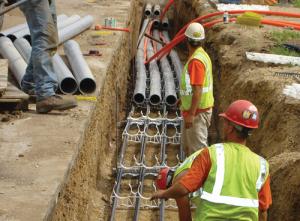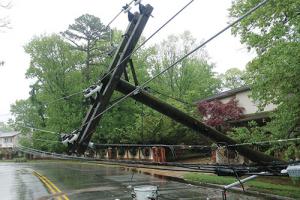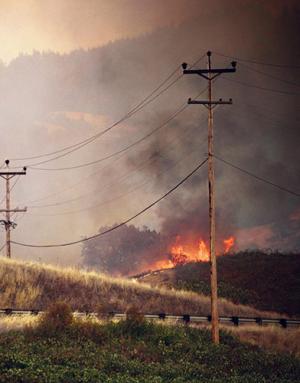2020’s Lessons on Grid Hardening
Mike Beehler has nearly forty years of electric T&D experience at Tucson Electric Power, Hawaiian Electric Co., and Burns & McDonnell. He is a civil/structural engineer and registered professional engineer in eight states. He is founding member and Chief Opportunity Officer of Mike Beehler & Associates, LLC and serves as National Spokesman for the Power Delivery Intelligence Initiative, www.pdi2.org/. Beehler is a Fellow in ASCE and Member of IEEE and CIGRE.
Even working within the most ideal conditions, operating a safe, reliable, affordable, and sustainable electric utility is a challenging task. Unfortunately, 2020 has been anything but ideal. A global pandemic, supply chain disruptions, massive fires in the west, and a significant increase in severe weather are just a few of the challenges utilities have faced and are still facing. This year has forced us to learn some hard lessons and ask important questions about the future of resiliency and hardening North America's electrical grid.
Utilities Prepare to Handle Multiple/Concurrent Crises

Utilities are no strangers to preparing for and responding to emergencies. However, decades of experience could not have prepared us for multiple and concurrent crises. With COVID-19 promptly followed by annual weather events and devastating fires, many utilities find themselves confronting a new crisis before having time to fully address the previous one. This Black Swan event has strained resources in ways that few would have predicted.
The historic effects of COVID-19 have had widespread implications on utilities usually well-prepared for and accustomed to crisis management:
Early on, lockdowns and social distancing requirements made it difficult to provide good customer service and respond to outages; Working with new pandemic guidelines meant prioritizing critical maintenance over non-critical work. Some utilities responded by increasing the number of shifts, staggering hours, and deploying small, fixed crews; and Supply chain disruption and limited availability of personal protective equipment increased restoration times and created financial stress for residential customers and businesses that remained open.
Though restrictions are beginning to ease in some areas, utilities are still dealing with the longer-term ramifications. Fortunately, much has been learned. Today, most utilities are prepared for the possibility of another wave and are bracing against further business and service disruptions.
 Mike Beehler: Electric utilities are best able to lead the dialogue, advocate for regulatory change, and propose cost-effective resilience solutions.
Mike Beehler: Electric utilities are best able to lead the dialogue, advocate for regulatory change, and propose cost-effective resilience solutions.
Severe weather events and massive wildfires have not pulled their punches because of a global pandemic. The National Oceanic and Atmospheric Administration (NOAA) predicted an above-normal hurricane season with as many as twenty-five named storms (more than double the historical yearly average). As of September 2020, the U.S. has seen fifteen named tropical storms and eight hurricanes this year.
Hurricane Isaias (August 4, 2020) left four million without power on the east coast. Damage from the storm could cost utilities more than three hundred and fifty million dollars in repairs. In Connecticut, Eversource removed thirty-five hundred downed trees and replaced a hundred and thirty-seven miles of power lines. "That's like building a whole new distribution system from scratch," said Frank Poirot, Eversource's senior media relations specialist.
Hurricane Laura (August 27, 2020) left an estimated nine hundred and eighty-nine thousand without power across Texas and Louisiana. Entergy's restoration costs may be anywhere from 1.5 to 1.7 billion dollars. With critical transmission structures damaged beyond repair, full restoration did not occur until late September.
Hurricane Sally (September 16, 2020) brought heavy rain and catastrophic flooding to the Gulf Coast, leaving five hundred and fifty thousand without power in Alabama, Georgia, and Florida. In Pensacola, the storm brought four months of rain in four hours and rainfall was measured in feet instead of inches in some areas. Total damage and clean up after Sally will cost eight to ten billion dollars.
 A crossarm topples, which has become more common as the number of natural disasters increases.
A crossarm topples, which has become more common as the number of natural disasters increases.
For the second time in history and the first since 2005, the end of the list was reached used for naming Atlantic storms, making it necessary to move to the Greek alphabet with Hurricane Beta making landfall the third week of September.
Even more concerning, data from NOAA shows the frequency of severe weather events is steadily increasing. From 1980 to 1989, billion-dollar weather events occurred on an average of only 2.9 per year. From 2010 to 2019 the average increased to 11.9.
As of July 2020, there has already been ten of these billion-dollar weather events. While calculating the value of billion-dollar events is affected by current inflation-impacted replacement costs, it is still a noteworthy metric indicating the increasing frequency of severe weather.
In addition to hurricanes, 2020 has been a particularly active year for wildfires. Between January 1 and September 28, 47,520 U.S. wildfires have affected over 7.4 million acres of land, an area nearly the size of the state of Maryland (compared to 39,476 wildfires and 4.3 million acres for the same period in 2019).
 Wildfires ravaged California, the Pacific Northwest, and other parts of the nation in 2020, a difficult year for natural disasters.
Wildfires ravaged California, the Pacific Northwest, and other parts of the nation in 2020, a difficult year for natural disasters.
Are we prepared to handle the collision of two new realities? The new normal of COVID-19 and pandemic-related health requirements has coincided with the new reality of increasing severe weather events and fires. Utilities should not only reevaluate disaster-response playbooks but must also consider the most cost-effective ways to build a more resilient power grid.
"Historically, the costs of installing and maintaining underground lines have been prohibitive and utilities have turned away from that option because it didn't make financial sense. I would challenge that today. The cost structure around undergrounding is changing and the cost of keeping overhead through storm season is going up. Going underground is beginning to make financial sense in certain areas." — Biren Patel, Electrical Engineer/PM at Biren Patel Engineering
Utilities Poised to Lead on Cost-Effective Resiliency Efforts
System resiliency is achieved by grid hardening, or physically changing infrastructure to reduce its susceptibility to damage. Resiliency is the ability to withstand a high-impact, low-probability event with little or no customer impact. Or, according to the North American Reliability Council, the effectiveness of a resilient infrastructure or enterprise depends upon its ability to anticipate, absorb, adapt to, and/or rapidly recover from a potentially disruptive event.
Hardening the grid increases its durability and stability — making it better able to withstand the impacts of severe weather and fire and potentially reduce the impacts of unexpected worldwide events like COVID-19. Utilities have a unique opportunity to take the lead on building system resiliency and developing best practices for monitoring, measuring, and assessing the results.
Electric utilities have the best data and access to world-class capabilities to assess resiliency levels, their cost-effectiveness, and life-cycle value versus initial capital cost. New metrics may be needed such as Total Length of Restoration to define the benefits to all customers.
Additionally, electric utilities are the key point of communication between consumers and regulators. Positioned between all relevant parties, electric utilities are best able to lead the dialogue, advocate for regulatory change, and propose cost-effective resilience solutions for long-term improvement that will provide stakeholder and shareholder value.
Unfortunately, electric utilities have the financial risk. Normally not adversely impacted by stock market volatility, U.S. utilities saw share prices fall by ten percent to thirty percent during COVID-19. Increasing severe weather and fire events bring financial risk.
The Need for A New Paradigm Is Clear
The events of the past year have sent many of us searching for better solutions. How do utilities cost-effectively improve resiliency and harden the grid to withstand future disasters?
New technology and construction methods are making resiliency programs more cost-effective. For example, the electric power industry has long held that overhead electric distribution is more cost-effective than underground distribution.
While the capital cost of overhead was less than underground distribution, the total life-cycle cost of ownership of overhead versus underground distribution has changed significantly. Recent construction, health profile assessment, component, and material technology advances now make underground more safe, reliable, and resilient than overhead over the life of the asset.
The life-cycle benefits of resiliency (undergrounding in particular) are being clearly documented and demonstrated. There is a growing body of evidence on the benefits of resiliency. For example, Dominion Energy and Florida Power & Light and their regulators are leading the way with strategic undergrounding. These utilities have started to underground poorly performing overhead distribution lines to shorten restoration times following major storms.
Dominion Energy's Strategic Underground Program (SUP) is a "system-wide initiative to shorten restoration times following major storms by placing certain outage-prone overhead electrical distribution lines and equipment underground." Stated benefits include:
Undergrounding lines that historically see the most damage reduces outage frequency and duration in the most damage-prone neighborhoods; Undergrounding significantly reduces restoration time (by days); Faster restoration decreases the economic impact of major storms; and Undergrounding the most outage-prone parts of the distribution system will increase overall reliability.
"In recent years, new electric lines serving housing developments, office parks, and campuses are placed underground. However, in many older neighborhoods, power and communication lines remain overhead, making them vulnerable to weather events. The COVID-19 pandemic has increased customers' needs for a more reliable and resilient power grid, with many residences acting as home offices and home schools.
Dominion Energy in Virginia has been investing in programs to increase the resiliency of its distribution system. For example, the Strategic Underground Program, which started in 2014 and targets the most outage-prone overhead tap lines and seeks to place them underground. One of the most effective tools to prevent tap line outages has been converting those lines to underground.
The goal of the SUP is to reduce the number of work-repair locations required to restore power outages following a major weather event, which will decrease the length of time other customers across the Dominion Energy service area are without power. Using a data-driven process to convert four thousand miles of the most outage-prone lines to underground could reduce restoration times following severe weather events by up to fifty percent.
Dominion Energy has a resilient electric distribution system that benefits our customers because we started such programs as the Strategic Underground Program and formed partnerships with our customers to underground more than fifteen hundred miles since its inception." — Karen Kinslow, Director of Grid Resiliency at Dominion Energy.
Florida Power & Light strategically targeted its worst-performing lateral feeders and is putting them underground. Approximately forty percent of the electric distribution across Florida is already underground.
Existing storm data and early pilot reports suggest a forty percent improvement in reliability and much better resiliency during major storms. Underground outage rates are around eighteen percent versus eighty-two percent for non-hardened overhead distribution lines and sixty-nine percent for hardened overhead distribution lines.
Resiliency Is the Answer For 2021 And Beyond
2020 has shown us the need to prepare for multiple new realities. Utilities are on the front lines of operating and maintaining critical infrastructure in North America. Electric utilities and their stakeholders will lead the way toward a new resiliency paradigm.
To that end, the Power Delivery Intelligence Initiative, or PDi2, is here to help support the industry. An organization of suppliers, consultants, and other stakeholders, the purpose of PDi2 is to achieve power grid resiliency and reliability at the lowest life-cycle cost.
In gathering and disseminating industry-leading data and information, we aim to help electric utilities determine which power delivery solutions — overhead or underground — add the greatest value.
A free resource, the Utility Infrastructure Resiliency Playbook, is designed to support electric investor-owned, municipal, and cooperative utilities throughout the U.S. and Canada in planning, gaining approval, and successfully implementing an electric infrastructure resiliency program that delivers quantifiable value.
Some of the individuals quoted in this article will participate in the upcoming scheduled panel discussions at Distributech 2021. Consider joining us to hear more about their experiences and perspectives on strategic undergrounding.
What have you learned from 2020? How has this affected your resiliency plans for 2021 and beyond? Let's continue the conversation and explore the most cost-effective resiliency programs and undergrounding strategies to deliver benefits now and in the years to come.
Lead image: Underground infrastructure featuring a 138-kV circuit utilizing a concrete encased duct bank serving as a conduit for power, fiber optic, and ground cables.




